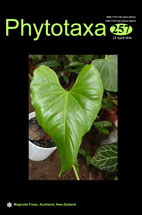Abstract
During a taxonomic revision of species belonging to Phylloporia, some collections from the Atlantic Forest of southern Brazil previously determined as P. spathulata had morphological discrepancies in comparison to the type material of this taxon. Both molecular phylogenetic and morphological analysis revealed them to be two distinct species, described here as Phylloporia elegans sp. nov. and P. nodostipitata sp. nov. They mainly differ from P. spathulata by having reviving basidiomata with smaller pores and basidiospores. Phylloporia nodostipitata develops caespitose basidiomata with a knotted and flexuous stipe and a tomentose pileal surface. Phylloporia elegans develops solitary basidiomata with a cylindrical and straight stipe and a plagiotrichoderm pileal surface. Both species are described, illustrated, discussed and compared with Phylloporia spathulata based on a study of the type. Phylloporia spathulata sensu stricto is presented based on its basionym type material.

